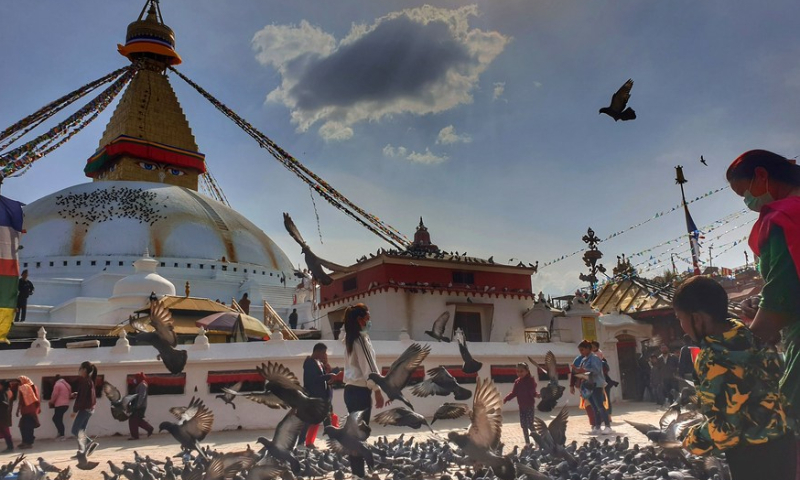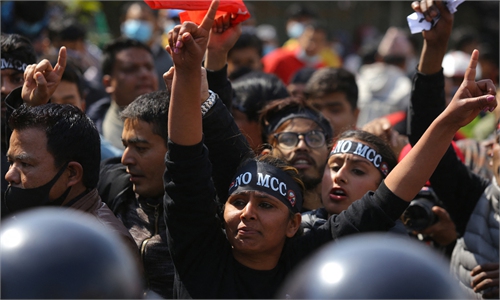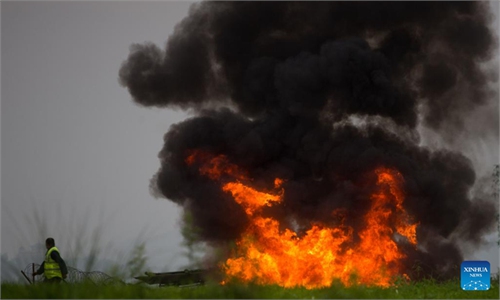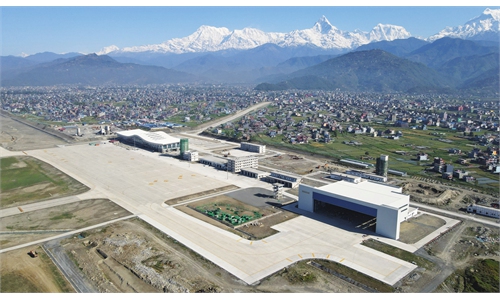IN-DEPTH / IN-DEPTH
Underlying efforts to push US-Nepal military pact not terminated despite of huge backlash: source

People feed pigeons around Boudhanath Stupa, the world heritage site in Kathmandu, capital of Nepal, March 18, 2020. Photo: Xinhua
The US has not given up efforts to push its military pack, the State Partnership Program (SPP), with Nepal. The process has not completely ended even two weeks after the Nepalese government announced its decision not to move ahead, a local source close to the matter told the Global Times. Meanwhile, the US has prepared another military cooperation scheme as an alternative of the SPP in an attempt to encourage the Nepalese Prime Minister, Sher Bahadur Deuba, to sign it during his upcoming official visit to Washington in mid-July, the source said.
The Nepal government, under an overwhelming backlash from the public, announced on June 20 that it will not move ahead on the SPP as it could bring harm to the country. However, many suspect that the deal has not been aborted as some political forces still secretly promote it.
Nepal has not written and sent the official letter to the US to inform the government's decision not to take part in the SPP, according to the spokesperson of the Nepal Ministry of Foreign Affairs on Sunday.
"So far, the SPP has not been fully suspended or rejected. The US is planning another security pact, an alternative to the SPP, to be possibly discussed during PM Deuba's upcoming visit to the US. The new pack covers a similar content of the SPP. Moreover, it is possible that Deuba will sign an arms purchase agreement worth $19.8 million with the US," said the source, adding that "the priority is still continuing the SPP. But if it does not work, an alternative plan is prepared."
Deuba is scheduled to fly to the US in mid-July but no official announcement has been made yet, local media reported.
The US will not give up the SPP easily. If the program cannot get approved due to a huge domestic backlash in Nepal, the US will plan alternative programs to encourage Nepalese pro-US political forces to make a move, Zhang Yongpan, a research fellow of the Institute of Chinese Borderland Studies under the Chinese Academy of Social Sciences, told the Global Times.
But the fundamental interests and overall national strategies of the US and Nepal do not overlap. A stable political situation may be more important to Nepal than the benefit of being inside the US' strategic circle. Therefore, the SPP project may eventually end up being discarded because it is against the Nepalese national interest. However, the US, which has never given up on using small countries like Nepal as pawns in its Indo-Pacific strategy, may yet push the SPP in a different way, said the expert.
Various means to pressure Nepal for SPP
After pushing Nepal to approve the Millennium Challenge Corporation (MCC) economic pact in March, the US urged the Himalayan country to join its SPP military alliance, which is widely believed to be another component of the US' Indo-Pacific Strategy, despite Washington's denial and calling it a development assistance.
Though government officials have claimed that Nepal has never been part of the SPP, an Indo-Pacific Strategy Report published by the US in February 2019 mentioned Nepal as a new entrant.
Nepalese media reported that the US renewed a push in mid-June on Nepal to participate in the SPP during the visit of Commanding General of the US Army Pacific, Charles Flynn, to the country. Flynn called for the signing of the SPP when he met with Nepalese Prime Minister Sher Bahadur Deuba and Chief of Staff of the Nepal Army General Prabhu Ram Sharma.
The militaries of Nepal and the US have been in partnership for decades. Nepal Chief of Army Staff General Prabhu Ram Sharma visited the US from June 27 to July 1, which local media called "increased high-level political and military engagements between Kathmandu and Washington."
Nepalese media outlet Kathmandu Post reported by citing sources that the commander of US Indo-Pacific Command, Admiral John Aquilino, visited Nepal before Sharma's journey to the US.
Earlier in December 2019, then US Assistant Secretary of Defense for Indo-Pacific Security Affairs, Randall Schriver, visited Kathmandu and held talks with then Nepal's defense minister Pokhrel and senior Nepal Army officials to discuss Nepal's inclusion in the SPP, the Kathmandu Post reported on July 3.
Widespread debate and overwhelmed criticism surged in the public opinion against both the US and Nepalese governments after the draft of a proposed agreement by the US Department of Defense on the SPP, between the US National Guard and the Nepal Army, was disclosed on June 13.
The disclosed six-page draft US proposal triggered a debate and faced backlash in Nepal for the possible US military presence in Nepal, which many warned contradicts Nepal's non-aligned foreign policy.
The draft agreement has 10 clauses, in which the US promises to provide Nepal $500 million for five years in addition to non-lethal equipment to the Nepal Army, the Kathmandu Post reported citing officials privy to the draft.
Whether it is the MCC or SPP, all the "unconditional assistance" from the US to Nepal must go through the American standard model of political power, market rules, human rights clauses and business standards which is difficult for Nepal to conform with. Most Nepalese see the "gift" as "a political benefit with strings" rather than a practical benefit to improve people's livelihood; therefore, the two sides have conflicting views on these issues with irreconcilable contradictions, Zhang told the Global Times.
"Pushing such pack will hamper their votes in the upcoming election in November. So, Nepalese politicians are concerned about cashing on the feelings of the general public. But after the election, the US may still play its full influence and pressure on its progress," Shristi Kafle, a Kathmandu-based independent journalist, told the Global Times.
Deep involvement and infiltration
The source told the Global Times that since 1951, the Central Intelligence Agency (CIA) has carried out its operations and activities in Nepal and the US has consistently maintained its engagement in various levels since then. "Their influence here has deep roots," said the source.
Member of the Nepal's National Assembly, Ram Narayan Bidari, initiated a proposal in January 2020 called "Nepal Special Service Bill" which aimed at checking the penetration of external intelligence agencies, including the CIA and India's Research and Analysis Wing (RAW), in the country, Nepalese media outlet My Republica reported.
"Foreign intelligence agencies CIA and RAW have been interfering in Nepal's internal politics and their activities need to be controlled. The bill states that it is necessary to control acts of 'secession, espionage, sabotage and subversion' and 'protect national sovereignty, national integrity and communal harmony'," said Bidari.
Taking advantage of the Nepalese government's openness to international organizations, the US has aggressively promoted the so-called NGOs landing in Nepal to promote American values and increase its influence in the country.
Statistics show that the highest number of NGOs registered in Nepal were from the US (53), followed by the UK (29) and Germany (12) and only one from the Chinese mainland.
Some Western-backed NGOs that have long been committed to separatism and incite anti-China feelings among "Tibetans in exile" in Nepal, such as the "Tibetan Youth Congress."
Zhang remarked that Nepal, as a small country, lacks the industrial and technological capacity to respond to emergencies, allowing the US to find a breach to intervene in the Himalayan region. For example, the US, a major player in climate change and geographical research, wants to get involved in research on snowmelt, glaciers and hydrology in the Himalayas. The US and Nepal's pro-US political forces are aligned on issues such as nature conservation and climate change, Zhang suggested.
On the other hand, the US uses its economic strength to increase trade with Nepal, which makes Katmandu more dependent on the US in some high-tech and civil aviation fields, experts said.
However, the differences and contradictions between the two countries are also obvious. In its treatment of Tibetan separatists in exile, for example, Nepal has never yielded to US pressure for separatists to engage in separatist activities against China on its territory. The Dalai Lama clique has repeatedly asked the US Special Coordinator for Tibetan issues to intervene in Nepal, but the local government has never surrendered, Zhang told the Global Times.
In another example, the support from the US government to political parties in Nepal is not consistent but depends on the best interests of the US. The fact that the US has supported the Communist Party of Nepal (Maoist Centre) and retracted its support more than once is enough to show that it never really had Nepal's interests in mind, he noted.
American influence and penetration in Nepal has been for years comprehensive, multi-dimensional and deep, observers say. However, there is a saying in Nepalese politics that Nepal is like an egg among boulders that carefully seeks balance. But the US has never really looked out for the balance of Nepal's politics and its own interests.




